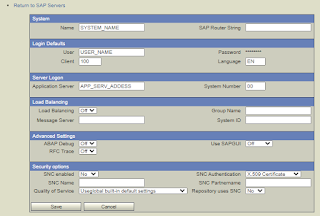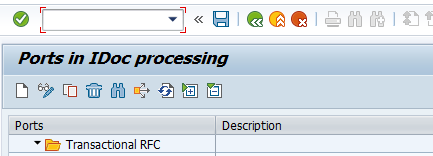1. Simple SQL function to read XML tags from string using regex
Tuesday, June 7, 2022
Google BigQuery - simple function to read XML tags with Regex
Google BigQuery SQL - calculate production by each hour of the shift
SAP - configure connection with external system with SAP BC and rfc idoc communication
1. SAP BC -> Adapters -> SAP -> Add sap server
(Previously create SAP user: SU01 tcode)
2. SAP BC -> Adapters -> SAP -> Choose SAP server -> Add listener to the server
(previously create PROGRAM_ID it in SMGW tcode)
3. Go to SAP BC-> Routing create routing rule for desired message typ
4. Create RFC connection in SM59 (test the connection)
5. Create the transnational RFC port in WE21 (add rfc destination from SM59)
6. Create a logical system in BD54
7.Create a partner profile with messages type in WE20
Thursday, January 27, 2022
Power shell - save sql query result to file
1. Simple script to run query and save it to file
$fileName = 'FILE_PATH'
$SQLServer = "SERVER_NAME"
$SQLDBName = "DATABASE_NAME"
$userid ="USER_NAME"
$password = "PASSWORD"
$delimiter = ";"
$SqlQuery = "SELECT * FROM TABLE_NAME";
#SQL Query
$SqlConnection = New-Object System.Data.SqlClient.SqlConnection
$SqlConnection.ConnectionString = "Server = $SQLServer; Database = $SQLDBName; User ID = $userid; Password = $password;"
$SqlCmd = New-Object System.Data.SqlClient.SqlCommand
$SqlCmd.CommandText = $SqlQuery
$SqlCmd.Connection = $SqlConnection
$SqlAdapter = New-Object System.Data.SqlClient.SqlDataAdapter
$SqlAdapter.SelectCommand = $SqlCmd
#Dataset and save to file
$DataSet = New-Object System.Data.DataSet
$SqlAdapter.Fill($DataSet)
$DataSet.Tables[0] | export-csv -Delimiter $delimiter -Path $fileName -NoTypeInformation
Powershell - upload file to ftp
1. Simple script for uploading files to ftp
$username = "FTP_USER"
$password = "FTP_PASSWORD"
$localFile = "LOCAL_FILE_PATH"
$remoteFile = "ftp://SERVER_ADDRESS/" + "FILENAME"
# Create FTP Rquest
$request = [System.Net.FtpWebRequest]::Create("$remoteFile")
$request = [System.Net.FtpWebRequest]$request
$request.Method = [System.Net.WebRequestMethods+Ftp]::UploadFile
$request.Credentials = new-object System.Net.NetworkCredential($username, $password)
$request.UseBinary = $true
$request.UsePassive = $true
# Read the File
$fileContent = gc -en byte $localFile
$request.ContentLength = $fileContent.Length
$run = $request.GetRequestStream()
$run.Write($fileContent, 0, $fileContent.Length)
# Close and dispose connection
$run.Close()
$run.Dispose()
ABAP - Editing segment, field values for multiple idocs
DATA: itab_edidd LIKE TABLE OF EDIDD WITH HEADER LINE,
itab_edidc LIKE TABLE OF EDIDC WITH HEADER LINE,
itab_edids LIKE TABLE OF EDI_DS40 WITH HEADER LINE.
DATA: P_SUM TYPE N LENGTH 4,
I_POS type I,
I_SUM type I,
I_LEN type I.
OBLIGATORY NO INTERVALS .
OBLIGATORY .
parameters P_SVALUE(999) type C
OBLIGATORY .
parameters P_POS(004) type N
OBLIGATORY .
parameters P_LEN(004) type N
OBLIGATORY .
loop at S_DOCNUM into s_sel.
CLEAR L_DOCNUM.
CLEAR itab_edidc.
CLEAR itab_edidd.
CLEAR itab_edidc.
* Asssign doc nbr
L_DOCNUM = s_sel-low.
IF L_DOCNUM IS NOT INITIAL.
EXPORTING
DOCUMENT_NUMBER = L_DOCNUM
* ALREADY_OPEN = 'N'
IMPORTING
IDOC_CONTROL = itab_edidc
TABLES
IDOC_DATA = itab_edidd
EXCEPTIONS
DOCUMENT_FOREIGN_LOCK = 1
DOCUMENT_NOT_EXIST = 2
DOCUMENT_NOT_OPEN = 3
STATUS_IS_UNABLE_FOR_CHANGING = 4
OTHERS = 5
.
IF SY-SUBRC <> 0.
MESSAGE ID SY-MSGID TYPE SY-MSGTY NUMBER SY-MSGNO
WITH SY-MSGV1 SY-MSGV2 SY-MSGV3 SY-MSGV4.
ENDIF.
LOOP AT itab_edidd.
IF itab_edidd-segnam = P_SNAME.
CLEAR P_SUM.
I_POS = P_POS.
I_LEN = P_LEN.
I_SUM = I_POS + I_LEN.
P_SUM = I_SUM.
CONCATENATE
itab_edidd-SDATA(P_POS)
P_SVALUE(P_LEN)
itab_edidd-SDATA+P_SUM INTO itab_edidd-SDATA
RESPECTING BLANKS.
MODIFY itab_edidd.
EXIT.
ENDIF.
ENDLOOP.
CALL FUNCTION 'EDI_CHANGE_DATA_SEGMENTS'
TABLES
idoc_changed_data_range = itab_edidd
EXCEPTIONS
idoc_not_open = 1
data_record_not_exist = 2
OTHERS = 3.
MESSAGE ID SY-MSGID TYPE SY-MSGTY NUMBER SY-MSGNO
WITH SY-MSGV1 SY-MSGV2 SY-MSGV3 SY-MSGV4.
ENDIF.
CALL FUNCTION 'EDI_CHANGE_CONTROL_RECORD'
EXPORTING
idoc_changed_control = itab_edidc
EXCEPTIONS
idoc_not_open = 1
direction_change_not_allowed = 2
OTHERS = 3.
MESSAGE ID SY-MSGID TYPE SY-MSGTY NUMBER SY-MSGNO
WITH SY-MSGV1 SY-MSGV2 SY-MSGV3 SY-MSGV4.
ENDIF.
REFRESH itab_edids.
itab_edids-docnum = L_DOCNUM.
itab_edids-status = 51.
itab_edids-repid = sy-repid.
itab_edids-mandt = sy-mandt.
itab_edids-tabnam = 'EDI_DS'.
itab_edids-stamqu = 'SAP'.
itab_edids-stamid = 'B1'.
itab_edids-stamno = 999.
itab_edids-stapa1 = ''.
itab_edids-stapa2 = ''.
itab_edids-logdat = sy-datum.
itab_edids-logtim = sy-uzeit.
APPEND itab_edids.
CALL FUNCTION 'EDI_DOCUMENT_CLOSE_EDIT'
EXPORTING
DOCUMENT_NUMBER = L_DOCNUM
DO_COMMIT = 'X'
DO_UPDATE = 'X'
WRITE_ALL_STATUS = 'X'
* STATUS_75 = '30'
TABLES
STATUS_RECORDS = itab_edids
EXCEPTIONS
IDOC_NOT_OPEN = 1
DB_ERROR = 2
OTHERS = 3.
MESSAGE ID SY-MSGID TYPE SY-MSGTY NUMBER SY-MSGNO
WITH SY-MSGV1 SY-MSGV2 SY-MSGV3 SY-MSGV4.
ENDIF.
ENDIF.
endloop.
Problem with database open ORA-19804, ORA-19809, ORA-03113
1. Try to login to database with SYS AS SYSDBA user. If the instance is idle, run the startup command. 2. If ORA-03113 occured, check the la...

-
SAP/ABAP: Connection to external database SAP, ORACLE, ABAP 1. Transaction code: ST04 - Add connection 2. Press “Add DB Entry”...
-
ORACLE RMAN: Delete archive logs older than X hours Oracle, RMAN 1. Create .bat script to start rman script rman @C:\RMAN_delete....
-
To assign access rights manually (to both users and groups) use secpol.msc → Local Policies → User Rights Assignment → Log on as batch job....

















